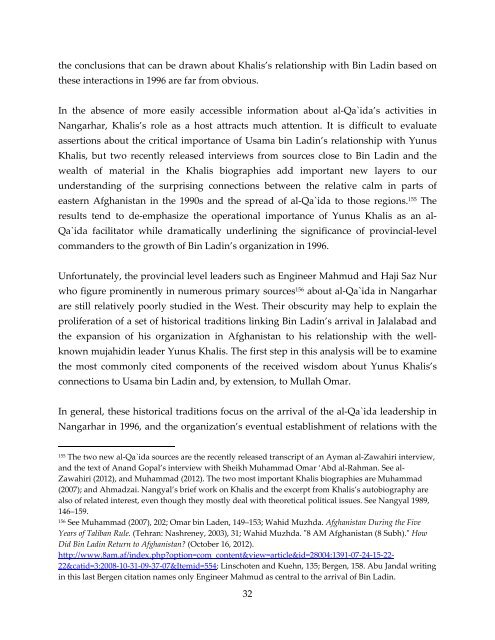Usama bin Ladin’s “Father Sheikh”:
Usama bin Ladin’s “Father Sheikh”:
Usama bin Ladin’s “Father Sheikh”:
You also want an ePaper? Increase the reach of your titles
YUMPU automatically turns print PDFs into web optimized ePapers that Google loves.
the conclusions that can be drawn about Khalis’s relationship with Bin Ladin based on<br />
these interactions in 1996 are far from obvious.<br />
In the absence of more easily accessible information about al‐Qa`ida’s activities in<br />
Nangarhar, Khalis’s role as a host attracts much attention. It is difficult to evaluate<br />
assertions about the critical importance of <strong>Usama</strong> <strong>bin</strong> <strong>Ladin’s</strong> relationship with Yunus<br />
Khalis, but two recently released interviews from sources close to Bin Ladin and the<br />
wealth of material in the Khalis biographies add important new layers to our<br />
understanding of the surprising connections between the relative calm in parts of<br />
eastern Afghanistan in the 1990s and the spread of al‐Qa`ida to those regions. 155 The<br />
results tend to de‐emphasize the operational importance of Yunus Khalis as an al‐<br />
Qa`ida facilitator while dramatically underlining the significance of provincial‐level<br />
commanders to the growth of Bin <strong>Ladin’s</strong> organization in 1996.<br />
Unfortunately, the provincial level leaders such as Engineer Mahmud and Haji Saz Nur<br />
who figure prominently in numerous primary sources156 about al‐Qa`ida in Nangarhar<br />
are still relatively poorly studied in the West. Their obscurity may help to explain the<br />
proliferation of a set of historical traditions linking Bin <strong>Ladin’s</strong> arrival in Jalalabad and<br />
the expansion of his organization in Afghanistan to his relationship with the well‐<br />
known mujahidin leader Yunus Khalis. The first step in this analysis will be to examine<br />
the most commonly cited components of the received wisdom about Yunus Khalis’s<br />
connections to <strong>Usama</strong> <strong>bin</strong> Ladin and, by extension, to Mullah Omar.<br />
In general, these historical traditions focus on the arrival of the al‐Qa`ida leadership in<br />
Nangarhar in 1996, and the organization’s eventual establishment of relations with the<br />
155 The two new al‐Qa`ida sources are the recently released transcript of an Ayman al‐Zawahiri interview,<br />
and the text of Anand Gopal’s interview with Sheikh Muhammad Omar ‘Abd al‐Rahman. See al‐<br />
Zawahiri (2012), and Muhammad (2012). The two most important Khalis biographies are Muhammad<br />
(2007); and Ahmadzai. Nangyal’s brief work on Khalis and the excerpt from Khalis’s autobiography are<br />
also of related interest, even though they mostly deal with theoretical political issues. See Nangyal 1989,<br />
146–159.<br />
156 See Muhammad (2007), 202; Omar <strong>bin</strong> Laden, 149–153; Wahid Muzhda. Afghanistan During the Five<br />
Years of Taliban Rule. (Tehran: Nashreney, 2003), 31; Wahid Muzhda. ʺ8 AM Afghanistan (8 Subh).ʺ How<br />
Did Bin Ladin Return to Afghanistan? (October 16, 2012).<br />
http://www.8am.af/index.php?option=com_content&view=article&id=28004:1391‐07‐24‐15‐22‐<br />
22&catid=3:2008‐10‐31‐09‐37‐07&Itemid=554; Linschoten and Kuehn, 135; Bergen, 158. Abu Jandal writing<br />
in this last Bergen citation names only Engineer Mahmud as central to the arrival of Bin Ladin.<br />
32


